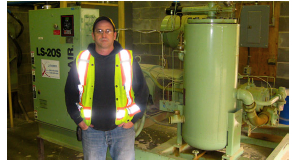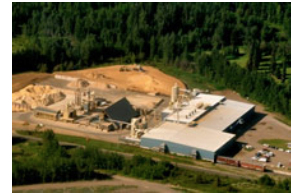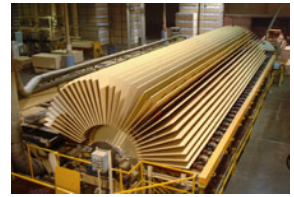 BC Hydro is a sponsor of Compressed Air Challenge and one of two Canadian utilities represented on the Board of Directors. BC Hydro’s Power Smart Compressed Air Optimization program helps customers assess how their air system is working, helps with project implementation costs and provides for onsite training of plant personnel. The following profiles tell how two of their customers discovered excellent savings through the application of low cost measures.
BC Hydro is a sponsor of Compressed Air Challenge and one of two Canadian utilities represented on the Board of Directors. BC Hydro’s Power Smart Compressed Air Optimization program helps customers assess how their air system is working, helps with project implementation costs and provides for onsite training of plant personnel. The following profiles tell how two of their customers discovered excellent savings through the application of low cost measures.
Catalyst Powell River's Little Fix Saves \$342,000 a Year
|
|
|
Catalyst employees (left to right) Paul MacLean, Ken Campbell and Tony Leach worked on a solution that resulted in fabrication of "mudflaps" – work done by sheet metal mechanic Peter Rowbotham – that removed the need for a costly use of compressed air. |
When Jennifer Mercer tallied up the energy savings from her first year as energy manager at Catalyst Paper's Powell River mill, she shared the news with staff in a "year in review" newsletter.
Then she got a surprise.
"I heard from Ken Campbell, the interim paper machine manager on paper machine 11, who told me about a fix they'd done on the machine," she recalls. "He said, 'I don't know if there are energy savings, but I just figured I'd let you know.'"
Campbell explained to Mercer that, for many years, two compressed air hoses had been used – at great expense – to blow away debris that would would have fallen on the paper sheet.
"Those air wands had been in place for years, certainly for the eight years since I've been here, and probably since close to the startup of the paper machine in 1981," says Campbell.
The solution was a borrowed idea from the company's mill in Snowflake, Arizona – installing "mudflaps" on the paper machine to do the same thing the air hoses were doing.
"It was a device first used in our Crofton division, although nobody else was using compressed air the way we were," says Campbell. "I thought, if we put those on, think of the money we would save."

A \$1,000 Fix Saves \$342,000 a Year
Campbell's team fabricated a metal flap solution that stops water and debris rather than allowing it to fall onto the paper sheet.
"When we installed them, we kept the air showers on for a couple weeks while we were trialing them, but then we shut them off and we haven't had them on since," says Campbell.
He estimates the cost of the fix – materials and labour – was about \$1,000.
 |
|
Jennifer Mercer, Energy Manager |
So simple was the employee-led solution that it didn't come to Mercer's attention until her year end report prompted Campbell's note. Then it became apparent just how valuable the "mudflaps" are.
"When I did the math on calculating 3/4 inch hoses continuously spraying compressed air onto the equipment I found each one is saving 930 cfm of compressed air," says Mercer. "And they were running 24/7; if the machine was down for maintenance days, they still ran. It was like running your garden hose full out, all the time."
Mercer did the math and was in for a welcome surprise. About \$171,000 per hose, in annual savings.
Says Campbell: "Back when it was easy to make bundles of money, this was never in the forefront. Now, you want to save whatever you can, and you want to be environmentally sound as well."
Campbell's team now makes identifying leaks a priority. "On shut down days when it's nice and quiet, we go around and listen, to minimize the amount of compressed air that we use here," he says."
Past Practices No Longer Add Up
"At some point in the past, they obviously had a problem, they needed a solution, and somebody said just put an air hose there," says Mercer. "So they just grabbed the closest compressed air line and hooked it up and no one really thought before about what the actual ramifications of making that decision was."
"Most people don't think about the cost of compressed air; they just think, 'It's just air, blowing.' But over 80% of your cost to produce compressed air is lost in heat," she says. "You spend money to compress it to get it at the right pressure that you need, and by making sure you're minimizing any of your wasteful streams, it allows you to operate your entire system more efficiently."
Catalyst's Powell River site has one of the largest, most complex compressed air systems in B.C.
"So we want to make sure that when we need it, it is available," she says. "If you're using a compressed air line to keep motor bearings cool, or you're using compressed air for building or process cooling, mixing, or to clean tools and equipment, you're throwing thousands of dollars out the window."
Compressed Air Study Helps Save Newpro \$40,000 a Year
 |
Roger Smith, Plant Manager, beside air compressor. |
When Northern Engineered Wood Products (Newpro) expanded its production capacity a few years ago, it was not surprised to discover that the plant's compressed air capacity also needed a boost.
But a few years later, there was a surprise. With a compressed air system study, Newpro was on a path to big savings with nearly no cost.
Newpro is a composite panel manufacturer based in Smithers. The plant uses waste residue from sawmills to produce composite wood panels that are commonly used in kitchen cabinets and office furniture.
 |
Aerial photo of NEWPRO particleboard plant, Smithers, B.C. |
The plant has been in operation since 1980 and has about 50 employees.
"The entire facility uses compressed air," says Roger Smith, Newpro's Plant Manager. "We've got two units that run 24 hours a day, seven days a week, about 350 days a year."
Up until 2007, Newpro's operations were powered by a single 150 hp compressor, with another of the same size in place as a backup. Then, they expanded.
"We put a new melamine paper overlay line in, and we found we didn't have enough air with just one compressor, so we found we needed the second compressor running," says Smith. "Unfortunately, it was running all the time, but it was probably only really needed, capacity wise, for about 20% of its capacity. So it was basically running and discharging and just wasting a lot more than we were actually using."
Energy Efficiency: Study Reveals Low-Cost Fixes
 |
View of the particleboard cooler |
Newpro partnered with BC Hydro to investigate efficiencies, and the initial compressed air study targeted storage.
With additional storage tanks, the plant could operate with just one compressor and still have capacity for peak usage times. But as they took steps towards their new project, more information came to light.
"Between the guys with the study and our maintenance staff, we found a problem in the system itself," says Smith. The problem lay in a minimum pressure check valve on one compressor.
"By repairing that — a relatively simple fix, a couple hundred dollars and about a half an hour — we were able to just shut that second compressor back off. We realized a huge savings just from that. The audit made a huge difference, even if it had done nothing more than just found that one problem in the system."
The other low cost fix Newpro implemented as the result of the audit was to change the operation of four small compressed air lines that were blowing air to keep dust off of photocell "eyes." They were running continuously — but the study found they could give one blast of air every hour or so without jeopardizing operations.
"Now they run intermittently instead of all the time — that was quite considerable savings as well," says Smith.
Savings Hit About \$40,000 a Year
As a result of the air study and some simple fixes, Newpro is now saving 599,000 kWh of electricity per year — or about \$40,000*.
"You know, we've got a full complement of maintenance staff, but we're not compressor experts," says Smith. "We'd been running since 2007 with two compressors, and [the problem valve] was just never discovered until the audit came along. All along we would have been able to run with just one compressor if it weren't for this mechanical problem in our system.
"What it really comes down to, in our discussions with BC Hydro, is that we found some fairly significant savings with really not doing much work. If it hadn't been for the audit, we would just have just continued to basically waste energy. It was about as simple as that."
* Based on an average blended rate of 6.7¢ per kWh.
For more information visit the Compressed Air Challenge® website or contact Ron Marshall, Marshall Compressed Air Consulting, tel: 204-806-2085, email: ronm@mts.net.
To read more System Assessment articles, please click here.





